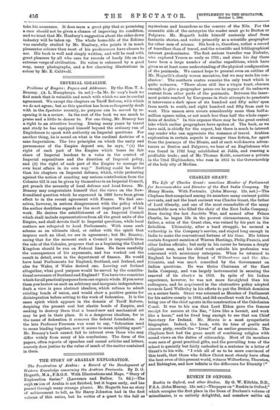Sport and Travel in the Northland of Canada. By David
T. Hanbury. (E. Arnold. 16s. net.)—Mr. Hanbury in this very interesting and readable contribution to the literature of recent travel describes an adventurous journey of twenty months through the "Barren Ground" which lies between the Great Slave Lake and the northern coast-line of Canada. The district which he traversed is practically unknown to white men, being too unkindly for the work of the Hudson's Bay Company ; but it contains the material for many exciting adventures, and repays the exertions alike of the sportsman and the explorer. Mr. Han- bury made his journey, in the first instance, in the interests of adventure ; but he was able to obtain much information that is of material assistance to geographers, and his book, with its full appendices of scientific observations, affords a model for the sportsman who desires to feel that his route is not merely marked by the bones of slaughtered animals. Now and then Mr. Hanbury shows himself to be more alive to the duties of the traveller than many professed geographers, as when he deprecates the too common plan of naming lakes, rivers, headlands, and so forth after one's European friends. "Whenever I have been in un- explored regions," he says, "I have invariably made it a strict rule to ascertain and adhere to local and native names, whether of lakes, mountains, rivers, or other physical features of the country, and I wish to lay particular stress upon the importance of following this plan, for it is of the greatest service to the traveller who finds himself in the country for the first time. If he has a map in his possession, and on this map finds the native name for every place, he will have no difficulty in making the natives understand the route he wishes to follow." Mr. Hanbury draws a very agreeable picture of the kindly and unspoilt Eskimo, or "Huskies," among whom he spent nearly two years. Their intelligence, honesty, and faithfulness make a pleasing contrast with the behaviour of most tribes of so low an order of civilisa. tion. Kr. Hanbury tells us that many of them were able to com- prehend a chart and follow his route on it the first time that they saw such a thing. This is almost incredible, but of course we take his assurance. It does seem a great pity that so promising a race should not be given a chance of improving its condition, and we trust that Mr. Hanbury's suggestion about the eider-down industry will be taken up. The whole home-life of the Eskimo was carefully studied by Mr. Hanbury, who paints it in much pleasanter colours than most of his predecessors have chosen to use. His book is well and simply written, and will be read with great pleasure by all who care for records of hardy life on the extreme verge of civilisation. Its value is enhanced by a good map, many photographs, and a few charming illustrations in colour by Mr. E. Caldwell.























































 Previous page
Previous page